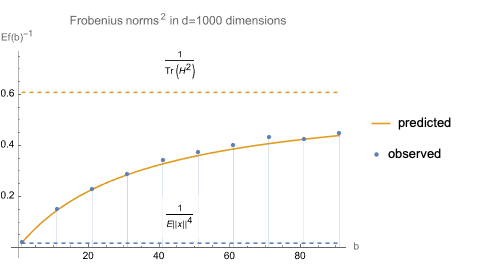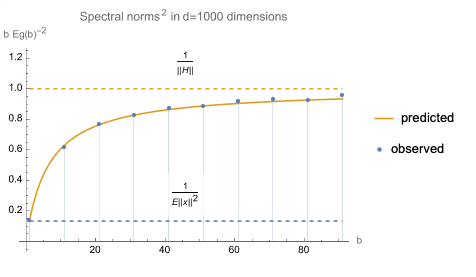Suppose $x_i \stackrel{\text{i.i.d}}{\sim} \mathcal{N}(\mu,\Sigma)$. What can we say about dependence on $b$ of Frobenius/spectral norm quantities below?
$$f(b)=\left\|\frac{1}{b}\sum_{i=1}^b x_i x_i^T\right\|_F^2$$
$$g(b)=\left\|\frac{1}{b}\sum_{i=1}^b x_i x_i^T\right\|$$
Empirically, the following gives a near perfect fit for some problems, how can this be explained?
$$E\frac{b}{f(b)} \approx \frac{1}{E f(1)}+ \frac{b-1}{Ef(\infty)}$$
$$E\left(\frac{b}{g(b)}\right)^2 \approx \frac{1}{E g(1)}+ \frac{b-1}{Eg(\infty)}$$
For instance, here's a check of this formula against empirically estimated quantities for 1000-dimensional Gaussian centered at zero and covariance matrix having eigenvalues $1,\frac{1}{2},\ldots,\frac{1}{1000}$.
Any pointers appreciated!
Edit we can write $f(b)$ in terms of Wishart random variable $W_b$ ($b$ degrees of freedom, covariance $\Sigma$). The following quantity has a simple dependence on $b$ (first graph)
$$E\left[\frac{b}{f(b)}\right]=E\left[\frac{b^3}{\operatorname{Tr}(W_b W_b^T)}\right]$$
Motivation: expected value of dot product squared for a random pair of vectors in a batch of size $b$ converges to $\operatorname{Tr}E[xx']^2$, behavior above suggests a way to estimate this value for finite $b$ which in term informs the largest useful batch size in mini-batch SGD, related question


